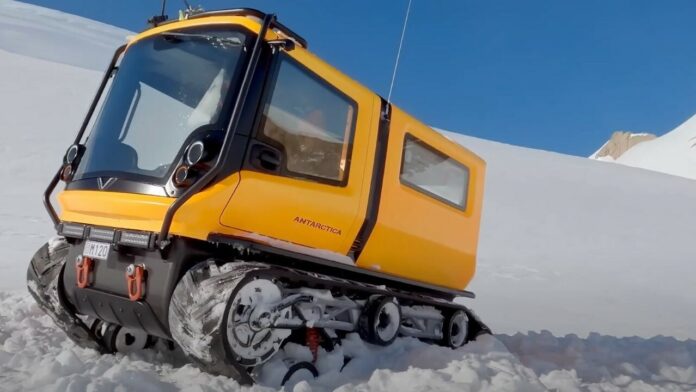The first battery-powered polar research vehicle is getting its first major tune-up to improve its performance in the summer.
The zero-emissions EV, which the scientists use to minimize the environmental impact of their work, was initially designed to be used in -50°C winter temperatures. But it’s summer in Antarctica until March, and the team found the vehicle, named the Venturi Antarctica, requires more cooling mechanisms to function as expected in the -10°C “heat.” As such, Venturi(Opens in a new window), the company that made the vehicle, made three modifications.
First, they replaced the sprockets, or the toothed wheels that propel the tank-like tracks. In hotter temperatures, spongey snow hardens on them, generating vibrations. Venturi’s Monaco-based R&D Department swapped them out for less snow-prone equipment.
Sprocket replacement on the Venturi Antarctica.
(Credit: Venturi)
Second, Venturi improved ventilation inside the vehicle’s pod-like compartment for a more comfortable ride. Although it’s hard to imagine needing more cooling in sub-zero temperatures, the new ventilation system allows “the interior temperature to be reduced when the sun and the power electronics generate too much heat,” Venturi says.
The final change involved more cooling—this time for the electronics at the base of the vehicle. New air intakes and vents on the front and rear will keep the hardware temperature down.
New cooling vents.
(Credit: Venturi)
The Venturi Antarctica is entering its second full year of operation. It first arrived at the Princess Elisabeth Antarctica(Opens in a new window) research station, the first zero-emissions station on the continent, in December 2021.
Recommended by Our Editors
“The Venturi Antarctica is the perfect fit for the zero emission concept of the Princess Elisabeth station. It’s an important advantage for the scientists and the team working at the station,” says Alain Hubert, head of the Belgian Antarctic Research Expeditions (BELARE). “This vehicle can be used for field missions while being recharged by the Princess Elisabeth Antarctica station’s renewable energy sources (wind and solar).”
The Princess Elisabeth Antarctica Research Station.
(Credit: antarcticastation.org)
Scientist inside the Venturi Antarctica.
(Credit: Venturi)
The station has completed dozens of studies(Opens in a new window) since 2007. They study the effects of climate change, marine diversity, polar ice shelves, and more. The team there uses the Venturi Antarctica EV for small trips, up to its 25-mile range.
“The consistency of the snow has an impact on range,” Venturi says. “This issue will be addressed by the next upgrades made to the vehicle.”
Get Our Best Stories!
Sign up for What’s New Now to get our top stories delivered to your inbox every morning.
This newsletter may contain advertising, deals, or affiliate links. Subscribing to a newsletter indicates your consent to our Terms of Use and Privacy Policy. You may unsubscribe from the newsletters at any time.
Hits: 1




















